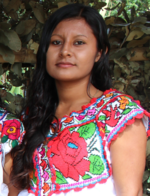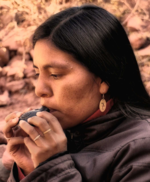Black hair
Human hair color From Wikipedia, the free encyclopedia
Black hair is the darkest and most common of all human hair colors globally, due to large populations with this trait. This hair type contains a much more dense quantity of eumelanin pigmentation in comparison to other hair colors, such as brown, blonde and red.[1] In English, various types of black hair are sometimes described as soft-black, raven black, or jet-black. The range of skin colors associated with black hair is vast, ranging from the palest of light skin tones to dark skin. Black-haired humans can have dark or light eyes, but more commonly dark.
This article possibly contains original research. (October 2020) |
Distribution
Black hair is the most common in Asia and Africa.[2] Though this characteristic can also be seen throughout Europe as well, it is considerably less common.[3] It can be found in Celtic populations such as in Ireland, Scotland and Wales.[4] Black hair can come in a variety of textures, just as any hair color. Generally, the East Asian, Central Asian and Native American population has straight hair with a very thick cuticle layer[5] and South Asians have thick, wavy or curly hair,[6] while the general hair type seen in black African hair is thick, curly and dense with more hair growing from the head. The curly quality comes from the shape of the hair follicle, as straight hair grows from more circular hair follicles, and curly hair grows from more oval-like follicles.[7]
Varieties of black hair
- raven black
Naturally, hair reflects light, which is why even black hair does not appear fully dark in the light. However, the darkest shade of black hair, raven-black, does not behave as other hair would in the light. The name of the color comes from a raven’s wing due to similarities in behavior. Appearing as being almost blue in some conditions, this hair color is mostly found with people from Africa, South and Southeast Asia, Central Asia and Latin America.[8]
True black hair is similar to a black cat's fur.


Genetics
Summarize
Perspective
Native Americans, East Asian, Southeast Asian, Far East Russian, South Asian, Central Asian and Himalayan black-haired people have thicker hair due to the derived EDAR gene allele that is linked to thicker and potentially straighter hair in some parts of Asia, and shovel-shaped incisors. The derived EDAR gene arose approximately 30,000 years ago in China.[10][11][12] One study[which?] shows that Paleo-Indians had both variants of the EDAR gene, the derived G-allele and the ancestral A-allele. When they[who?] tested ancient DNA remains found in the Americas of the individuals named USR1, Anzick-1 and Laranjal-6700 the results showed that they carried the ancestral A-allele.[citation needed]
11,000-year-old remains of Cuncaicha and Lauricocha individuals from South America share alleles at the highest rate with present-day Amerindians, indicating that the derived G-allele increased in frequency in parallel with the ancestral A-allele.[13]
One of the most studied genes that produce brown hair is MC1R, which helps the body to produce the melanocortin protein. This protein in turn helps the body's hair follicles to produce the type of melanin called eumelanin. To have black hair, one must have genetically inherited this gene from both of their parents, and brown hair is achieved when it is inherited from one parent. This gene is demographically common, as 90% of the total world population carries this gene. Black hair, along with brown hair, comes to turn grey in old age as the hair follicles can no longer produce the pigmentation, but the cause of this inability has yet to be determined.[14]
Gallery
- Chinese girl with black hair.
- Native American with black hair from South America.
- Native American with black hair from North America.
- Native American with black hair from South America.
- Chinese-Indonesian man with black hair from behind.
See also
References
External links
Wikiwand - on
Seamless Wikipedia browsing. On steroids.




